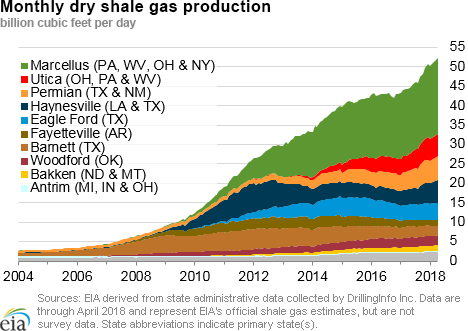In the News:
Bangladesh begins LNG imports, six more countries to follow
In April 2018, Bangladesh became the newest country to begin imports of liquefied natural gas (LNG). In the next two years, six more countries—Panama, Gibraltar, Russia, Philippines, Ghana, and Bahrain—are expected to start importing LNG, adding a combined 2.1 billion cubic feet per day (Bcf/d) of new regasification import capacity.
In 2017, global LNG trade expanded by a record 10% (3.5 Bcf/d) compared to the prior year, with 19 exporting countries and 40 importing countries engaged in LNG trade. By 2022, once all regasification terminals currently under construction are completed, global regasification capacity is projected to expand by 13.1 Bcf/d (a 12% increase) compared to 2017 and reach 125 Bcf/d. Although, historically, global nameplate regasification capacity far exceeded LNG imports (capacity utilization averaged 32%–38% annually over the past ten years), utilization of the new regasification capacity is expected to be higher as many of the new regasification terminals will serve specific downstream projects, have associated long-term LNG import contracts, and/or are built in markets with rapidly growing natural gas demand.
Most of the new regasification capacity coming online in 2018–22 is located in China and India, which are projected to add 7.3 Bcf/d (combined), accounting for 55% of the total global capacity additions in this period. Regionally, Asia (including China and India) will lead the growth in global regasification capacity additions with 8.5 Bcf/d under construction (65% of the total global additions). Other projected additions to the global total include:
- The Middle East (Bahrain and Kuwait) at 2.3 Bcf/d (18%)
- Brazil and Panama at 1 Bcf/d (8%)
- Europe (Belgium, Greece, Russia, Finland, and Gibraltar) at 0.8 Bcf/d (6%)
- Africa (Ghana) at 0.45 Bcf/d (3%)
Almost three-quarters of the new capacity additions (9.5 Bcf/d) will be located onshore, and 3.6 Bcf/d of the new regasification capacity will include offshore terminals connected to Floating Storage and Regasification Units (FSRUs).
Panama is expected to become the newest LNG importer as the country prepares to take its first LNG shipment in the coming weeks. Panama’s Costa Norte regasification facility (0.2 Bcf/d) is located in Colon, near the entrance to the Panama Canal on the Atlantic Ocean, and will initially serve the adjacent 380 MW capacity LNG-fired AES Colon power plant. It will also serve the new 420 MW capacity Gas-to-Power Panama natural gas-fired power plant, which is expected to come online by 2020.
Overview:
(For the Week Ending Wednesday, May 30, 2018)
- Natural gas spot prices fell at most locations this report week (Wednesday, May 23 to Wednesday, May 30). The Henry Hub spot price fell from $2.86 per million British thermal units (MMBtu) last Wednesday to $2.83/MMBtu yesterday.
- At the New York Mercantile Exchange (Nymex), the June 2018 contract expired Tuesday at $2.875/MMBtu. The July 2018 contract price decreased to $2.885/MMBtu, down 7¢ Wednesday to Wednesday.
- Net injections to working gas totaled 96 billion cubic feet (Bcf) for the week ending May 25. Working natural gas stocks are 1,725 Bcf, which is 31% lower than the year-ago level and 22% lower than the five-year (2013–17) average for this week.
- The natural gas plant liquids composite price at Mont Belvieu, Texas, rose by 14¢, averaging $8.83/MMBtu for the week ending May 30. The price of natural gasoline, propane, and butane fell by 4%, 1%, and 2%, respectively. The price of ethane and isobutane rose by 6% and 13%, respectively.
- According to Baker Hughes, for the week ending Tuesday, May 22, the natural gas rig count decreased by 2 to 198. The number of oil-directed rigs rose by 15 to 859. The total rig count increased by 13, and it now stands at 1,059.
Prices/Supply/Demand:
Spot prices fall across the Lower 48 states. This report week (Wednesday, May 23 to Wednesday, May 30), the Henry Hub spot price fell 3¢ from $2.86/MMBtu last Wednesday to $2.83/MMBtu yesterday. At the Chicago Citygate, prices decreased 8¢ from $2.74/MMBtu last Wednesday to $2.66/MMBtu yesterday. Prices at PG&E Citygate in Northern California fell 1¢, down from $3.04/MMBtu last Wednesday to $3.03/MMBtu yesterday. In contrast, the price at SoCal Citygate increased 70¢ from $2.46/MMBtu last Wednesday to $3.16/MMBtu yesterday, with a high of $3.70/MMBtu on Tuesday. Prices at SoCal Citygate remain volatile amid ongoing supply constraints.
Northeast price movements are mixed. At the Algonquin Citygate, which serves Boston-area consumers, prices went up 11¢ from $2.43/MMBtu last Wednesday to $2.54/MMBtu yesterday. Algonquin prices reached a weekly low of $2.13/MMBtu on Friday as hot temperatures were expected to moderate over the holiday weekend, reducing cooling demand. At the Transcontinental Pipeline Zone 6 trading point for New York City, prices decreased 15¢ from $2.87/MMBtu last Wednesday to $2.72/MMBtu yesterday. Transcontinental Pipeline Zone 6 prices also reached a weekly low on Friday, falling to $2.63/MMBtu.
Tennessee Zone 4 Marcellus spot prices decreased 10¢ from $1.17/MMBtu last Wednesday to $1.07/MMBtu yesterday, with a high of $1.46/MMBtu on Friday. Prices at Dominion South in northwest Pennsylvania rose 17¢ from $2.23/MMBtu last Wednesday to $2.40/MMBtu yesterday.
June Nymex contract expires, and July contract falls. At the Nymex, the June 2018 contract expired Tuesday at $2.875/MMBtu, down 4¢ from last Wednesday. The July 2018 contract decreased to $2.885/MMBtu, down 7¢ from last Wednesday to yesterday. The price of the 12-month strip averaging July 2018 through June 2019 futures contracts declined 5¢ to $2.881/MMBtu.
Supply rises as domestic production continues its growth. According to data from PointLogic Energy, the average total supply of natural gas rose by 1% compared with the previous report week. Dry natural gas production grew by 1% compared with the previous report week, averaging 80.2 Bcf/d. This change represents an increase of 11% since this time last year when dry production averaged 71.9 Bcf/d. Average net imports from Canada increased by 2% compared with the previous report week.
Demand remains flat. Total U.S. consumption of natural gas was unchanged from the previous report week, averaging 56.7 Bcf/d according to data from PointLogic Energy. Natural gas consumed for power generation climbed by 7% week over week, as hot weather in the South and Midwest increased electricity demand. Industrial sector consumption decreased by 1% week over week. In the residential and commercial sectors, consumption declined by 19%, though this decrease only represented about 1.7 Bcf/d of natural gas because heating demand is normally low at this time of year. Natural gas exports to Mexico increased 2%.
U.S. LNG exports decrease week over week. Four LNG vessels (combined LNG-carrying capacity 14.4 Bcf) departed the United States from May 24 through May 30 (all from the Sabine Pass liquefaction terminal). One tanker (LNG-carrying capacity 3.3 Bcf) was loading at the Cove Point terminal on Wednesday, May 30.
On May 25, the Federal Energy Regulatory Commission (FERC) granted Sabine Pass Liquefaction (a subsidiary of Cheniere) permission to introduce natural gas to the fuel system of the fifth train at its Sabine Pass liquefaction terminal, beginning the commissioning process. The train is currently scheduled to be completed in 2019.
Storage:
Net injections fall just short of the five-year average. Net injections into storage totaled 96 Bcf for the week ending May 25, compared with the five-year (2013–17) average net injections of 97 Bcf and last year's net injections of 80 Bcf during the same week. This reporting period ends a three-week streak of net injections exceeding the five-year average. Net injections during the week averaged 13.7 Bcf/d; net injections will have to average 13.1 Bcf/d for the remainder of the refill season to match the five-year average level (3,815 Bcf) by October 31. Working gas stocks totaled 1,725 Bcf, which is 500 Bcf lower than the five-year average and 788 Bcf lower than last year at this time. The deficit to the five-year average peaked at 534 Bcf earlier this year during the week ending April 20.
Despite low storage inventories, the average January 2019 futures contract price trades at a lower premium to the average spot price than last year at this time. During the most recent storage week, the average natural gas spot price at the Henry Hub averaged $2.81/MMBtu while the Nymex futures price of natural gas for delivery in January 2019 averaged $3.14/MMBtu, 33¢/MMBtu higher than the spot price. A year ago, the January contract was 47¢/MMBtu higher than the spot price.
Reported net injections into storage are on the low end of analysts’ expections. According to The Bloomberg survey of natural gas analysts, estimates of the weekly net change from working natural gas storage ranged from net injections of 96 Bcf to 107 Bcf, with a median estimate of 102 Bcf. At the 10:30 a.m. release of the Weekly Natural Gas Storage Report (WNGSR), the price of the Nymex futures contract for July delivery at the Henry Hub increased 2¢/MMBtu to $2.97/MMBtu, with 1,129 trades executed. Prices continued to rise in subsequent trading, climbing to $2.98/MMBtu.
Temperatures are in the normal range for the storage week. Temperatures in the Lower 48 states averaged 66 degrees Fahrenheit (°F), 2°F higher than normal and 1°F higher than last year at this time.
See also:
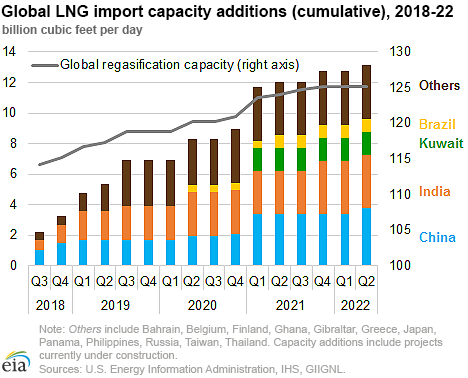
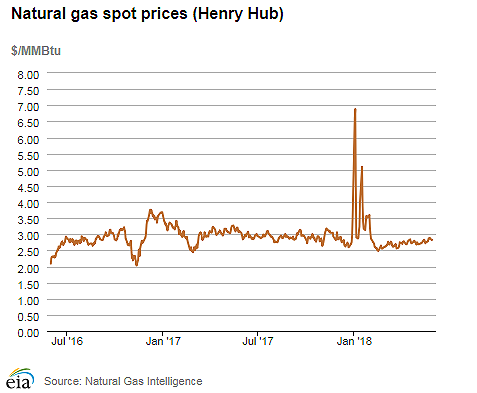
| Spot Prices ($/MMBtu) | Thu, 24-May |
Fri, 25-May |
Mon, 28-May |
Tue, 29-May |
Wed, 30-May |
|---|---|---|---|---|---|
| Henry Hub | 2.87 | 2.89 | Holiday | 2.82 | 2.83 |
| New York | 2.75 | 2.63 | Holiday | 2.79 | 2.72 |
| Chicago | 2.69 | 2.68 | Holiday | 2.62 | 2.66 |
| Cal. Comp. Avg.* | 2.36 | 2.38 | Holiday | 2.44 | 2.43 |
| Futures ($/MMBtu) | |||||
| June Contract | 2.940 | 2.939 | Holiday | 2.875 | Expired |
| July Contract | 2.971 | 2.963 | Holiday | 2.903 | 2.885 |
| August Contract | 2.988 | 2.983 | Holiday | 2.923 | 2.905 |
| *Avg. of NGI's reported prices for: Malin, PG&E Citygate, and Southern California Border Avg. | |||||
| Source: Natural Gas Intelligence | |||||
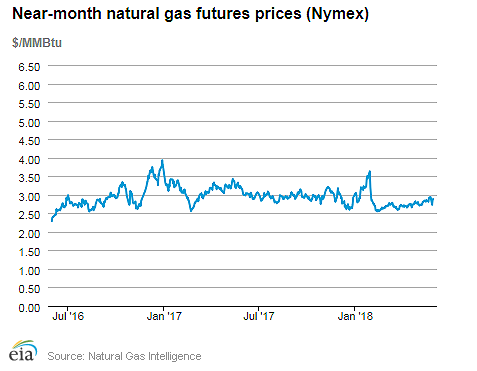
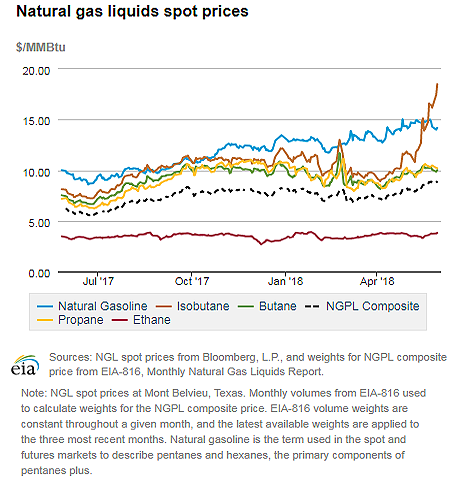
| U.S. natural gas supply - Gas Week: (5/24/18 - 5/30/18) | |||
|---|---|---|---|
Average daily values (Bcf/d): |
|||
this week |
last week |
last year |
|
| Marketed production | 90.5 |
90.0 |
81.1 |
| Dry production | 80.2 |
79.7 |
71.9 |
| Net Canada imports | 6.4 |
6.3 |
5.5 |
| LNG pipeline deliveries | 0.1 |
0.1 |
0.1 |
| Total supply | 86.6 |
86.0 |
77.4 |
|
Source: OPIS PointLogic Energy, an IHS Company | |||
| U.S. natural gas consumption - Gas Week: (5/24/18 - 5/30/18) | |||
|---|---|---|---|
Average daily values (Bcf/d): |
|||
this week |
last week |
last year |
|
| U.S. consumption | 56.7 |
56.7 |
53.6 |
| Power | 29.9 |
27.9 |
23.7 |
| Industrial | 19.6 |
19.9 |
19.9 |
| Residential/commercial | 7.2 |
8.9 |
10.0 |
| Mexico exports | 4.4 |
4.3 |
4.1 |
| Pipeline fuel use/losses | 6.4 |
6.4 |
6.0 |
| LNG pipeline receipts | 2.8 |
2.8 |
1.6 |
| Total demand | 70.2 |
70.1 |
65.4 |
|
Source: OPIS PointLogic Energy, an IHS Company | |||
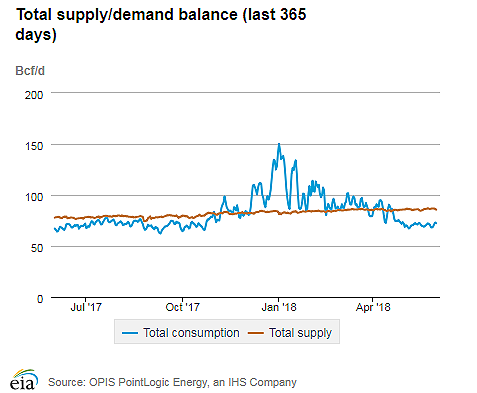
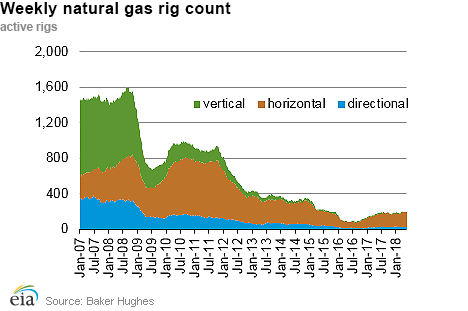
| Rigs | |||
|---|---|---|---|
Tue, May 22, 2018 |
Change from |
||
last week |
last year |
||
| Oil rigs | 859 |
1.8% |
19.0% |
| Natural gas rigs | 198 |
-1.0% |
7.0% |
| Note: Excludes any miscellaneous rigs | |||
| Rig numbers by type | |||
|---|---|---|---|
Tue, May 22, 2018 |
Change from |
||
last week |
last year |
||
| Vertical | 66 |
8.2% |
-14.3% |
| Horizontal | 926 |
0.8% |
20.9% |
| Directional | 67 |
1.5% |
3.1% |
| Source: Baker Hughes Inc. | |||
| Working gas in underground storage | ||||
|---|---|---|---|---|
Stocks billion cubic feet (Bcf) |
||||
| Region | 2018-05-25 |
2018-05-18 |
change |
|
| East | 328 |
299 |
29 |
|
| Midwest | 315 |
288 |
27 |
|
| Mountain | 113 |
107 |
6 |
|
| Pacific | 221 |
213 |
8 |
|
| South Central | 748 |
722 |
26 |
|
| Total | 1,725 |
1,629 |
96 |
|
| Source: U.S. Energy Information Administration | ||||
| Working gas in underground storage | |||||
|---|---|---|---|---|---|
Historical comparisons |
|||||
Year ago (5/25/17) |
5-year average (2013-2017) |
||||
| Region | Stocks (Bcf) |
% change |
Stocks (Bcf) |
% change |
|
| East | 415 |
-21.0 |
429 |
-23.5 |
|
| Midwest | 582 |
-45.9 |
475 |
-33.7 |
|
| Mountain | 166 |
-31.9 |
139 |
-18.7 |
|
| Pacific | 257 |
-14.0 |
270 |
-18.1 |
|
| South Central | 1,094 |
-31.6 |
912 |
-18.0 |
|
| Total | 2,513 |
-31.4 |
2,225 |
-22.5 |
|
| Source: U.S. Energy Information Administration | |||||
| Temperature – heating & cooling degree days (week ending May 24) | ||||||||
|---|---|---|---|---|---|---|---|---|
HDD deviation from: |
CDD deviation from: |
|||||||
| Region | HDD Current |
normal |
last year |
CDD Current |
normal |
last year |
||
| New England | 48 |
-2 |
9 |
2 |
0 |
-17 |
||
| Middle Atlantic | 26 |
-12 |
-2 |
6 |
-1 |
-15 |
||
| E N Central | 33 |
-11 |
-11 |
9 |
-5 |
-1 |
||
| W N Central | 26 |
-12 |
-46 |
28 |
10 |
25 |
||
| South Atlantic | 1 |
-13 |
-5 |
64 |
18 |
-4 |
||
| E S Central | 0 |
-13 |
-5 |
62 |
26 |
6 |
||
| W S Central | 0 |
-2 |
-5 |
81 |
16 |
21 |
||
| Mountain | 38 |
-14 |
-35 |
22 |
-3 |
-1 |
||
| Pacific | 31 |
-2 |
23 |
1 |
-8 |
-25 |
||
| United States | 24 |
-9 |
-7 |
31 |
5 |
-3 |
||
|
Note: HDD = heating degree day; CDD = cooling degree day Source: National Oceanic and Atmospheric Administration | ||||||||
Average temperature (°F)
7-Day Mean ending May 24, 2018
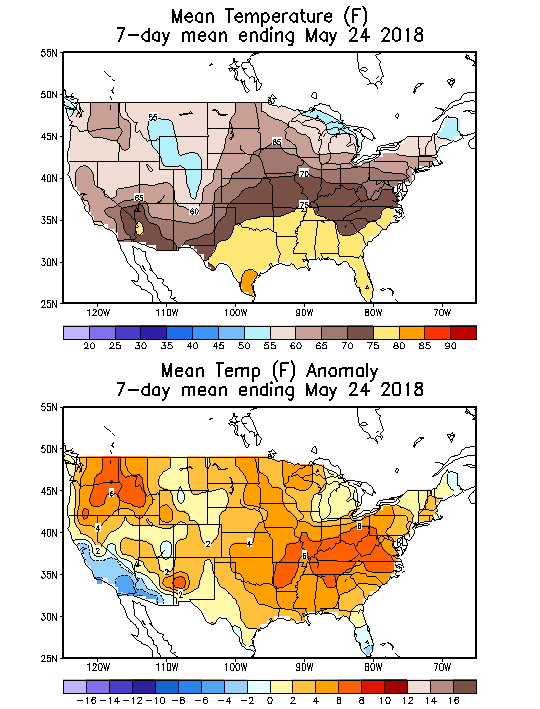
Source: NOAA National Weather Service
Deviation between average and normal (°F)
7-Day Mean ending May 24, 2018

Source: NOAA National Weather Service

